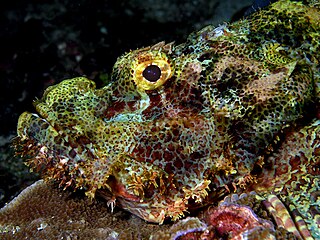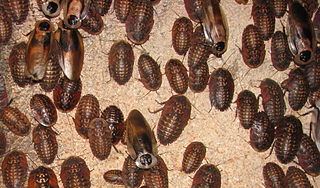
Cyprinidae is a family of freshwater fish commonly called the carp or minnow family. It includes the carps, the true minnows, and relatives like the barbs and barbels. Cyprinidae is the largest and most diverse fish family and the largest vertebrate animal family in general with about 3,000 species, of which only 1,270 remain extant, divided into about 370 genera. Cyprinids range from about 12 mm in size to the 3 m (9.8 ft) giant barb. By genus and species count, the family makes up more than two-thirds of the ostariophysian order Cypriniformes. The family name is derived from the Greek word kyprînos.

The sap beetles, also known as Nitidulidae, are a family of beetles.

Myliobatiformes is one of the four orders of batoids, cartilaginous fishes related to sharks. They were formerly included in the order Rajiformes, but more recent phylogenetic studies have shown the myliobatiforms to be a monophyletic group, and its more derived members evolved their highly flattened shapes independently of the skates.

The family Psittacidae or holotropical parrots is one of three families of true parrots. It comprises the roughly 10 species of subfamily Psittacinae and 157 of subfamily Arinae, as well as several species that have gone extinct in recent centuries. Some of the most iconic birds in the world are represented here, such as the blue-and-gold macaw among the New World parrots and the grey parrot among the Old World parrots.

The Scorpaenidae are a family of mostly marine fish that includes many of the world's most venomous species. As their name suggests, scorpionfish have a type of "sting" in the form of sharp spines coated with venomous mucus. The family is a large one, with hundreds of members. They are widespread in tropical and temperate seas but mostly found in the Indo-Pacific. They should not be confused with the cabezones, of the genus Scorpaenichthys, which belong to a separate, though related, family, Cottidae.

Giant cockroaches, or blaberids are the second-largest cockroach family by number of species.

The Drepanidae are a family of moths with about 660 species described worldwide. They are generally divided in three subfamilies) which share the same type of hearing organ. Thyatirinae, previously often placed in their own family, bear a superficial resemblance to Noctuidae. Many species in the drepanid family have a distinctively hook-shaped apex to the fore wing, leading to their common name of hook-tips.

Noctuoidea is the superfamily of noctuid or "owlet" moths, and has more than 70,000 described species, the largest number of for any Lepidopteran superfamily. Its classification has not yet reached a satisfactory or stable state. Since the end of the 20th century, increasing availability of molecular phylogenetic data for this hugely successful radiation has led to several competing proposals for a taxonomic arrangement that correctly represents the relationships between the major lineages.

Trichomycteridae is a family of catfishes commonly known as pencil catfishes or parasitic catfishes. This family includes the candiru fish, feared by some people for its alleged habit of entering into the urethra of humans. They are one of the few parasitic chordates. Another species is the life monsefuano which was important to the Moche culture and still an important part of Peruvian cuisine.

Sisoridae is a family of catfishes. These Asian catfishes live in fast-moving waters and often have adaptations that allow them to adhere to objects in their habitats. The family includes about 235 species.

Brentidae is a cosmopolitan family of primarily xylophagous beetles also known as straight-snouted weevils. The concept of this family has been recently expanded with the inclusion of three groups formerly placed in the Curculionidae; the subfamilies Apioninae, Cyladinae, and Nanophyinae, as well as the Ithycerinae, previously considered a separate family. They are most diverse in the tropics, but occur throughout the temperate regions of the world. They are among the families of weevils that have non-elbowed antennae, and tend to be elongate and flattened, though there are numerous exceptions.

Clusiidae or "druid flies" is a family of small, thin, yellow to black acalyptrate flies with a characteristic antenna and with the wing usually partially infuscated. They have a cylindrical body. The head is round, the vertical plate reaches the anterior margin of the frons and the vibrissae on the head are large. The costa is interrupted near subcosta and the latter developed throughout length. Larvae are found in the bark of trees, the flies on trunks. The larvae are notable for their ability to jump. Males of many species in the subfamily Clusiodinae have been observed while engaged in lekking behaviour. There are hundreds of species in 14 genera found in all the Ecoregions, although most species occur in tropical regions. The type genus is Clusia Haliday, 1838.

Lutjanidae, or snappers are a family of perciform fish, mainly marine, but with some members inhabiting estuaries, feeding in fresh water. The family includes about 113 species. Some are important food fish. One of the best known is the red snapper.

Hypsibius dujardini sensu lato is a species complex of tardigrade in the class Eutardigrada. A member of this complex, Hypsibius exemplaris, is widely used for various research projects pertaining to evolutionary biology and astrobiology.

Pelodryadinae, also known as Australian treefrogs, is a subfamily of frogs found in the region of Australia and New Guinea, and have also been introduced to New Caledonia, Guam, New Zealand, and Vanuatu.

Phyllomedusinae is a subfamily of hylid tree frogs found in the Neotropics commonly called leaf frogs. Formerly, they were often considered as their own family, Phyllomedusidae.
The Micronoctuini are a tribe of moths in the family Erebidae that includes about 400 described species. Typical species in the tribe have bifine hindwing venation and are smaller than those in other noctuoid moths. Micronoctua karsholti is the smallest of all species in the superfamily Noctuoidea.

Cicadettinae is a subfamily of cicadas in the family Cicadidae. About 230 genera and 1,200 described species are placed in the Cicadettinae.

The UPLB Museum of Natural History is a natural science and natural history museum within the University of the Philippines Los Baños (UPLB) campus. It serves as a center for documentation, research, and information of flora and fauna of the Philippines. The museum is one of the research and extension units of the UPLB and its role parallels that of a library for written records.

















